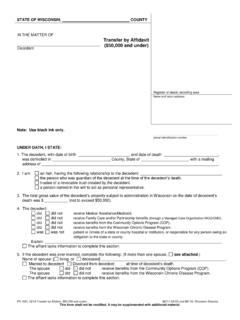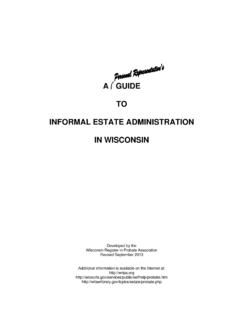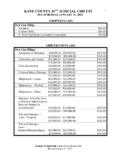Transcription of Guide to appellate procedure for the self-represented
1 Revised 8/2015 Guide to appellate procedure for the self - represented Clerk of the Wisconsin Supreme Court and Court of Appeals 110 East Main Street, Suite 215 Box 1688 Madison, WI 53701-1688 (608) 266-1880 The Guide to appellate procedure for the self - represented is not legal advice and cannot be cited as legal authority. This Guide is not intended to replace or to be a substitute for the Wisconsin Rules of appellate procedure , and should be used in conjunction with the Rules. Anyone considering initiating an appeal may wish to seek legal counsel. This Guide to appellate procedure for the self - represented is based upon the Wisconsin Rules of appellate procedure in effect as of July 1, 2015. CLERK OF THE WISCONSIN SUPREME COURT AND COURT OF APPEALS 110 EAST MAIN STREET, SUITE 215 BOX 1688 MADISON, WISCONSIN 53701-1688 Patience Roggensack Chief Justice TELEPHONE (608) 266-1880 FACSIMILE (608) 267-0640 WEB SITE: Lisa S.
2 Neubauer Chief Judge Dear Friend: The goal of this Guide is to provide general information to assist individuals in understanding the appeals process and to help non-lawyers with the basic steps and procedures for filing an appeal in the Wisconsin Court of Appeals and Supreme Court. This Guide focuses primarily on appeals to the Court of Appeals (the intermediate-level court which hears criminal and civil appeals from Wisconsin s circuit courts), but also deals with some types of cases heard by the Supreme Court. The Frequently Asked Questions section is intended to be an introduction to concepts related to the appeals process. The question and answer format provides definitions of terms and general information about deadlines, fees, and the options available at the various stages of an appeal. Subsequent sections provide contact information for the Clerk s Office, links to useful websites, information on types of appeals and how to get your appeal started, more detail regarding the requirements of Briefs, Appendices, and Motions, and checklists for use in preparing these documents.
3 There is a Glossary of terms associated with appeals, and several of the most commonly used forms are appended to this Guide for your convenience. Please keep in mind that this Guide is not a substitute for legal counsel or a thorough understanding of the Wisconsin Rules of appellate procedure . It is not and does not purport to be a complete explanation of all aspects of Wisconsin appellate procedure ; such an explanation would require a much longer and more complex document than this Guide . If you have comments or questions about this Guide or about appellate procedure , please do not hesitate to contact the Clerk s Office at or 608-266-1880. The Clerk s Office is dedicated to serving the citizens of Wisconsin, and we hope that this Guide is a useful tool for navigating the complex appeals process. Clerk of the Wisconsin Supreme Court and Court of Appeals TABLE OF CONTENTS I. Frequently Asked Questions About the appellate Process.
4 1 II. General Information about Clerk/Internet Resources .. 10 III. Types of Appeals .. 11 IV. Initiation of an Appeal in the Court of Appeals .. 12 A. Civil Cases .. 12 B. Criminal Cases .. 13 C. Termination of Parental Rights Cases .. 14 D. Permissive Appeals .. 14 E. Applying for Indigent Status .. 15 V. Motions .. 16 VI. Briefs .. 18 VII. Appendices .. 22 VIII. Motion for Reconsideration/Petition for Review .. 24 IX. Writs and Original Actions .. 25 X. No-Merit Appeals .. 26 XI. Deadlines/Number of Copies .. 28 XII. Miscellaneous procedures .. 30 Recovering Costs in the Court of Appeals .. 30 Voluntary Dismissal .. 30 Publication .. 30 Sanctions .. 31 XIII. Glossary of Terms .. 32 XIV. Sample Forms .. 35 Frequently Asked Questions about the appellate Process Guide to appellate procedure for the self - represented Page 1 FREQUENTLY ASKED QUESTIONS ABOUT THE appellate PROCESS Q. What is an appeal? A. If you go to court, and you are not satisfied with the court s judgment or order, you are entitled to appeal that judgment or order to the Court of Appeals.
5 An appeal asks the Court of Appeals to look at what the circuit court did to determine if the circuit court made the right decision or followed the correct procedure . Unless the appeal is an appeal by permission (explained below), the order appealed from must be a final judgment or order from the circuit court. An individual or party who appeals a circuit court judgment or order is called an Appellant in the Court of Appeals. The individual or party who must respond to the appeal (most often the opposing party in the circuit court) is called the Respondent. Q. What is a judgment or order? A. A judgment is a ruling made by a circuit court judge. It usually comes at the end of a case and usually favors one of the parties. The judgment, sometimes referred to as an order, often requires one or both of the parties to do something. The judgment is usually in writing and explains why the court ruled the way it did. Many civil cases end when one party asks for summary judgment.
6 A motion for summary judgment filed by one of the parties asks the judge to rule in its favor prior to a trial. If the circuit court grants summary judgment resolving all the issues in the case in favor of one party, the other party can appeal that decision. A judgment that does not resolve all the issues in the case is referred to as a nonfinal judgment. In order to appeal a nonfinal judgment, an appellant must request permission to appeal. See Permissive Appeals in Section III of this Guide . An order or judgment must be in writing and must be entered (that is, filed in the office of the circuit court clerk) before the Court of Appeals has jurisdiction to review it. The date of entry is the date the document is filed with the circuit court clerk. With a few exceptions, an appeal from an oral judgment or order will be Q. Who can appeal? A. With few exceptions, any party who is dissatisfied with the result in the circuit court has the right to appeal, with or without the assistance of an attorney.
7 The process of an appeal is complicated, time-consuming, and difficult, however, and the assistance of an attorney is recommended. No special treatment is given to parties who represent themselves. Like attorneys, a self - represented party (also known as a pro se party) must comply with the requirements of the Wisconsin Rules of appellate procedure . 1 An exception to the rule that the judgment or order must be in writing and entered exists for final dispositions in small claims, traffic regulation or municipal ordinance violations prosecuted in circuit court. An appeal in one of these types of cases may be taken from a disposition of the case recorded in the circuit court clerk s case record entries, and the time for appeal begins to run when the entry is made. I Frequently Asked Questions about the appellate Process Guide to appellate procedure for the self - represented Page 2 Q. What types of courts are there?
8 A. In sixty-six of Wisconsin s seventy-two counties, there is a circuit court that serves that county s residents. In the other six counties, one circuit court serves two counties (Buffalo/Pepin, Florence/Forest, and Shawano/Menominee). Some counties have several courts, with some hearing criminal cases and others hearing civil cases or small claims cases. The next level above the circuit court is the Wisconsin Court of Appeals. If you are dissatisfied with the final judgment in the circuit court, you may appeal the judgment to the Court of Appeals. The next level above the Court of Appeals is the Wisconsin Supreme Court. If you are dissatisfied with the judgment of the Court of Appeals, you may ask the Wisconsin Supreme Court to look at your case. Q. What is the difference between a criminal case and a civil case? A. A criminal case is where a person is charged with violating one of Wisconsin s criminal laws. In a criminal case, the State of Wisconsin, represented by the District Attorney (also referred to as the Prosecutor), may bring the accused person to trial.
9 In a criminal case, the State is the plaintiff and the accused person is the defendant (because that person must defend himself or herself against the accusation). If the defendant is found guilty, the defendant may appeal that judgment to the Court of Appeals. A civil case is where individuals, groups of individuals, or companies (called parties or litigants) are in conflict and ask the court to resolve that conflict. Civil cases can involve disputes over contracts, automobile accidents, injuries, divorce, child custody , and many other issues. If any party to the case is dissatisfied with the court s ruling in the case, that party can appeal the court s final ruling to the Court of Appeals. Q. How much does it cost to appeal? A. The filing fee to open a case in the Court of Appeals is $ This filing fee is due once the Notice of Appeal is filed in the circuit court. Payment may be made to the circuit court clerk or sent to the Clerk of the Court of Appeals.
10 A copy of the Notice of Appeal must be sent to the Clerk of the Court of Appeals. If you believe that because of poverty, you are unable to pay the filing fee, you may apply for indigent status, under which you will be exempt from payment of the filing fee. See Applying for Indigent Status in Section IV of this Guide . If a Transcript is requested, there are fees that the Court Reporter will charge to prepare the transcript for the Court. Even if a party is granted indigent status, the court reporter, in some circumstances, can still charge to prepare the transcript. The circuit court can explain those costs. There are also costs involved with preparing documents for the Court as well as getting copies made. Most filings in the Court of Appeals require multiple copies as many as ten in the case of briefs. Thus, there are expenses for copying documents in addition to the filing fee, the cost of copying portions of the Record on Appeal, and the cost of preparing any transcripts in the case.









